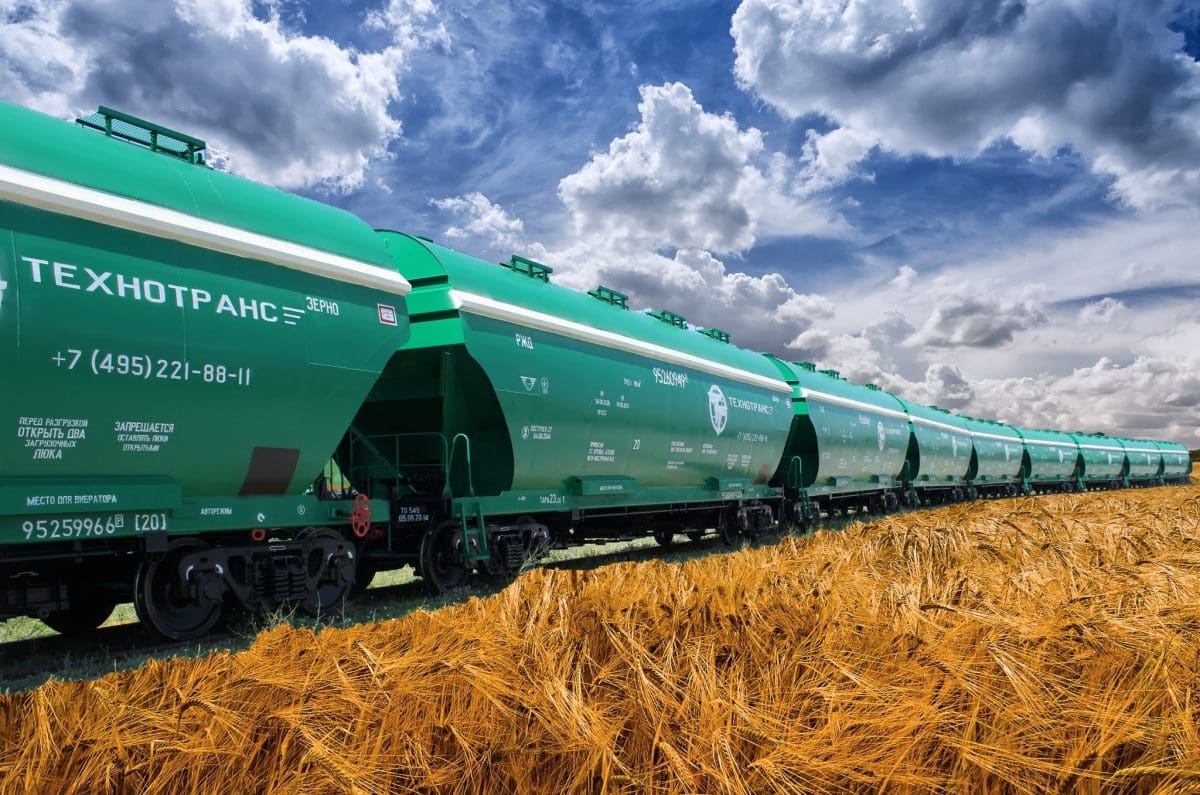
Russian grain makes its way to export. File photo: Tehnotrans
A HIGH level of conjecture remains around the final size of this year’s wheat harvest in Russia, with some widely varying forecasts released in recent weeks. Dry weather throughout the growing season has had a dramatic impact on yields following record production last year.
Last Thursday Russian agricultural consultancy IKAR reduced its 2021-22 season wheat crop forecast to 74-75 million tonnes (Mt). Lower-than-expected yields in several regions compelled IKAR to revise its August crop forecast of 77Mt. IKAR singled out the country’s Central, Volga and Ural regions as the worst hit by below-average rainfall that has seen production plummet from 85.9Mt in 2020. IKAR pegged the Russian barley harvest in the 17.5-18Mt range, suggesting their production bias for barley was also lower after forecasting an 18Mt crop last month. The consultancy’s corn production forecast is 14-14.5Mt, with total Russian grain output expected to fall in the 117.5-120Mt range. Russian grain exports will be 39.5-40.5Mt, including 31-31.5Mt of wheat, according to IKAR.
Leading consultancy and Black Sea market analyst Sovecon has Russian wheat production slightly higher than IKAR at 75.4Mt. At 33.9Mt, its wheat export estimate is also higher, although the export tax continues to play havoc with Russia competitiveness into some traditional high-volume markets. As a result, Sovecon expects an extended export program, stretching well into the second half of the 2021-22 marketing year which commenced on July 1.
The USDA is setting the low mark this year with its current wheat-production forecast at 72.5Mt, 15 per cent lower than its final 2020-21 output of 85.35Mt. The USDA has exports at 35Mt, which seems high considering domestic consumption is around 40Mt. This pushes ending stocks down to just under 10Mt, but still slightly higher than the average of the last four years at 9.75Mt. At the high end of wheat production estimates is the Russian Grain Union. It has reportedly raised its harvest forecast last week from 76Mt to 78-78.5Mt, indicating the yield gap compared to last season was not as high as expected. It expects more favourable production outcomes as the harvest moves into the Siberian spring wheat regions, contrary to market reports suggesting additional abandonment of spring wheat areas due to meagre yields.
As a result of the production upgrade, RGU is now calling wheat exports for the 2021-22 marketing year in the 35.5-36Mt range, higher than its previous forecast of 34Mt. The Union has the total Russian crop pegged at 119.5Mt, up from 118Mt in its last update.
The Russian winter and spring crop harvests are now around 90pc complete, with around 24.4 million hectares (Mha) covered thus far. The Russian Ag Ministry says there is 97.2Mt of grain in the bin, including 70.7Mt of wheat and 17.3Mt of barley.
According to Russian Federation Customs Service Statistics, wheat exports in the first seven months of 2021 were 14.1Mt, down 6.2pc year on year. However, the value of those exports rose by 12.3pc to US$3.6 billion, a reflection of the higher global grain values in 2021.
In July, the first month of the new marketing year, Russia exported 1.8Mt of wheat, down 20.9pc year on year and down 20.7pc compared to June. This highlights the impact of the export tax on shipments in June, as the trade scrambled to move as much wheat as possible before the new tax formula came into effect in July.
Winter wheat area drops
Meanwhile, Russian farmers are expected to plant less winter wheat this year as the autumn planting program ramps up. A record area was planted last year, but below-average rainfall thus far, displeasure with the current export tax regime, and a switch to oilseeds, are all contributing to the decrease, according to local reports. Additionally, extensive replanting of failed winter-cropping areas in the Central and Volgograd regions with spring wheat varieties means the harvest of these paddocks will be much later than normal. That makes it highly unlikely that they will all get harvested and then replanted for the new-crop campaign before the winter sets in and halts field activity.
Russian farmers prefer to plant winter wheat over spring wheat as it is much higher yielding and is generally less susceptible to adverse summer weather. Accordingly, winter wheat typically makes up around 70pc of the total area planted to wheat. That said, winter wheat is not suited to the Urals and Siberia, where winters are long and extreme, and the growing season is extremely short.
While recent rains have improved the seeding outlook, the winter planting program is still lagging last year’s pace. As of September 14, around 7.8Mha had been sown to winter crop compared to 8.2Mha at the same time in 2020.
Sovecon is calling the new-crop winter wheat area lower by as much as 1Mha, down 5.6pc compared to the 17.8Mha planted in 2020. IKAR is a little more conservative, calling the area reduction only 500,000ha.
The counterargument here is solid farm profitability. Much to the chagrin of Moscow, higher global wheat prices have countered the effect of the export tax on farm-gate wheat values. This means that returns for most farm businesses remain quite buoyant relative to recent seasons. While farmers will plant some of their crop dry, it will more likely be a lack of soil moisture rather than the export tax that has the greatest influence on the final wheat area this year.

HAVE YOUR SAY